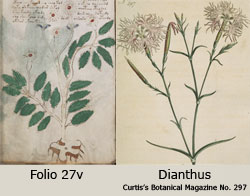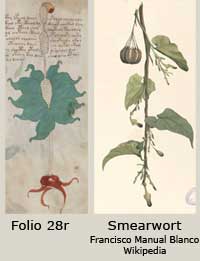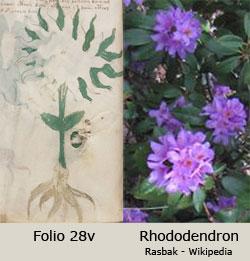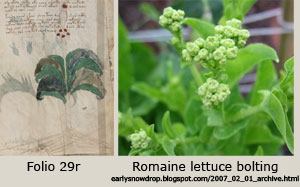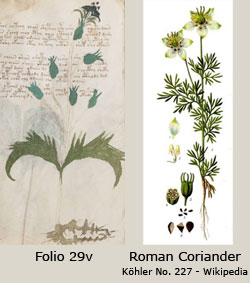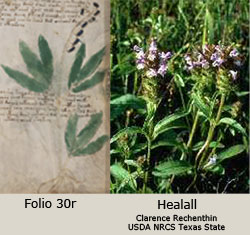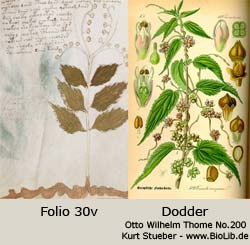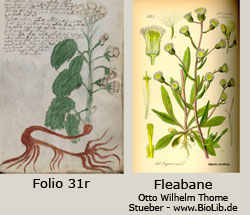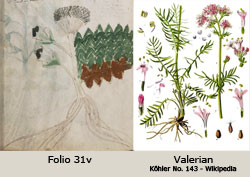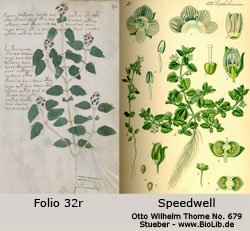The Voynich Botanical Plants
Folio 27v, Dianthus (Dianthus superbus), is a low-growing, perennial herb native to Europe and Northern Asia. The name comes from the Greek words dios meaning “god” and anthos, “flower”, and was cited by the Greek botanist Theophrastus. The plant has linear, opposite, grey-green leaves. The pale-pink, sweet-smelling flowers have five, frilly-fringed petals with a greenish base, and are produced in clusters at the top of the stems. The foliage can be eaten or boiled to make a drink.
Folio 28r, Smearwort, Birthwort, or Pipevine (Aristolochia species), is a vine occurring in different climates and has been an important herb since the time of the ancient Egyptians, Greeks, and Romans. The leaves are simple and alternate. The flowers grow in the leaf axils; they are inflated and spherical at the base, followed by a long tube and ending in a tongue-shaped, brightly colored lobe. The ancient Egyptians used birthwort during childbirth to help expel the placenta. Pipevines contain a disinfectant which helps heal wounds. The plant is referenced in an early herbal.
Folio 28v, Rhododendrons, are widely distributed throughout the Northern Hemisphere. The name comes from the Greek: rhodos meaning “rose”, and dendron, “tree.” The leaves are spirally arranged around clusters of large, pink, red, or white flowers. The Greek soldier Xenophon (431 to 355 BC), a contempory of Socrates, noted that some of his soldiers became ill after eating honey made from the nectar of rhododendron flowers. These plants produce a toxin that is fatal for horses and has a slightly hallucinogenic and laxative effect on humans.
Folio 29r, Romaine or cos lettuce (Lactuca sativa L. var. longifolia), apparently originated on the Greek island of Cos and reached the West via Rome, hence the name “romaine.” It has a long head with sturdy leaves. When a lettuce plant begins to flower its stem lengthens and branches and it produces flower heads similar to a dandelion only smaller. Folio 29r shows this plant just starting to flower. The photograph of Romaine lettuce in flower comes from: earlysnowdrop blog site. Lettuce secretes a milky fluid from the base of its stems, known as lettuce opium. This fluid is also secreted by wild lettuce. It is considered to have sedative and analgesic properties and was used by the Ancient Egyptians.
Folio 29v, Roman coriander (Nigella sativa), is an annual plant in the ranunculus family, native to Southern Europe, North Africa, and Southwest Asia. It has finely divided, linear leaves and pale blue or white flowers with 5 to 10 petals. The fruit is a balloon-like capsule containing numerous seeds. The seeds are frequently referred to as black cumin and are used in Asian and Middle Eastern cooking.
Folio 30r, Healall (Prunella vulgaris), is a common herb found in pastures throughout Europe. The stems of the linear leaves are attached in pairs down the main stem. The cylindrical flower spike, unlike most flower spikes, maintains its shape as it grows in length. The plant propagates from a creeping stem, that sends out roots when a new flower spike forms. Ancient herbalists used to wash wounds and ulcers with an infusion of healall. It is currently being investigated as a possible treatment for herpes.
Folio 30v, Dodder (Cuscuta europaea), is a leafless, rootless, parasitic weed, of which four species are found in Northern Europe. It obtains water and nutrients by attaching itself to a suitable host, which in the case of the two drawings shown here appears to be a mint plant. The small white, pink, or yellow flowers occur in tight balls along the thread-like stem. Dodder’s selection of a host appears to be based on the smell of the volitile chemicals the host plant emits.
Folio 31r, Fleabane (Erigeron acris), has a cosmopolitain distribution with the highest diversity of species in North America. It is closely related to the plant in Folio 27v, both being members of the aster family. It has an erect stem, alternate leaves shaped like a narrow spoon, and white ray flowers with yellow discs. It has a taproot so the plant spreads by re-seeding and often forms loose colonies. The leaves were used as a cooked or raw vegetable. People in the middle ages believed that the dried plant could repel fleas.
Folio 31v, Valerian, is native to Europe and Northern Asia. The roots merge into an erect rhizome, the leaves are arranged in pairs, each leaf consisting of a series of lance-shaped segments, and the flowers are small, white, and sweetly scented. This herb has been used for its sedative properties since the days of ancient Greece and Rome.
Folio 32r, Speedwell (Veronica triphyllos), belongs to a species of herbs native to temperate regions of the Northern Hemisphere. It has a fibrous root system and simple, opposite leaves. Its blue flowers are adapted for cross-fertilization, the stamens and style projecting from the flower and forming a place for insects to land. The astringent leaves were once used to treat wounds and skin diseases.
